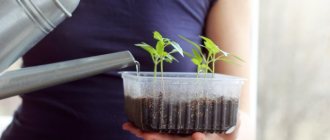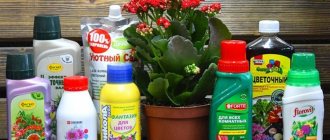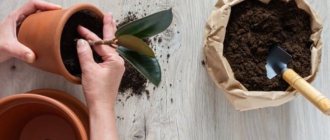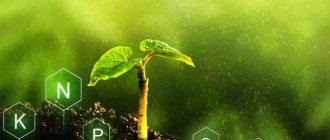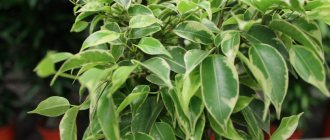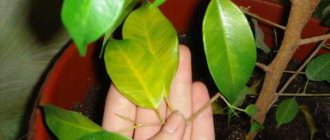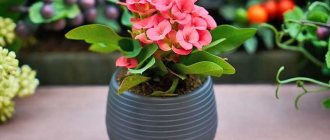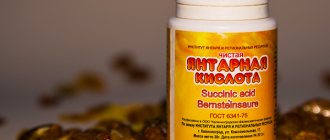Sooner or later, every gardener thinks about how to feed indoor plants so that they develop and bloom better. And this is where the fun begins, because there are many fertilizers. Which one should you choose? Let's figure it out together!
When choosing food for indoor plants, you should consider many factors. The type of plant, its state of health, the period of development - these are just the main points that you should pay attention to before starting the procedure. To orient you in the world of fertilizers, we will consider their main types, advantages and disadvantages.
Mineral fertilizers for feeding indoor plants
As you know, all plants need nitrogen, potassium and phosphorus, as well as various microelements (iron, copper, boron, manganese, sulfur, etc.). It is thanks to these substances that full growth and flowering are ensured and immunity is increased. The appearance of the leaves and stems will tell you that the plant is missing some element. But you shouldn’t let the plant become exhausted; it’s better to feed it regularly, at least in small quantities. We will look at which ones are better to choose below.
Mineral fertilizers for potted flowers are usually produced in liquid and dry forms (granules, powder, tablets, capsules and sticks). In terms of their composition, they can contain only one nutrient element (for example, nitrogen or phosphorus) or a complex of them (universal fertilizers). Mineral fertilizers should be used throughout the season, usually from spring to autumn. If you buy a ready-made product, always pay attention to the ratio of nitrogen, phosphorus and potassium (NPK) in its composition.
- NPK - what is it, how to determine the composition and amount of fertilizer
What kind of mysterious abbreviations are found on every pack of fertilizer and why are they needed in the daily life of an ordinary gardener?
Thus, the 11-6-9 ratio with a large amount of nitrogen is more suitable for young plants that need to increase their green mass. If the numbers are approximately like this - 7-9-13 - then the fertilizer contains a lot of phosphorus and potassium, which are necessary for flowering plants. The 13-15-18 mark usually indicates that the fertilizer is universal, it has all three components balanced, and it can be used in all situations.
You can also find ready-made products for succulents, ficus, violets, etc. in stores. Such drugs are very convenient to use. But if you have many different colors, then the situation becomes more complicated. Not everyone can afford to buy a package of products for each flower. And the expiration date may expire before you use up the drug. Therefore, in this situation, it is better to choose fertilizers for all types of plants. A note about this will appear on the packaging.
Look for products labeled “chlorine-free” and “nitrate-free.”
Typically, for healthy plants, choose a universal liquid fertilizer, which is diluted in water and applied according to instructions 1-2 times a month. The advantage of such fertilizers is that they can be used not only for watering, but also for spraying. Among the popular brands that produce fertilizers are the following: Agricola, Fasco, Zdraven, Pocon, Bona Forte, etc. When choosing, be sure to study the packaging and instructions for use.
An excess of nutrients is much more dangerous than a deficiency, so carefully monitor the appearance of the plant and if signs of an overdose appear (excessive growth of green mass, brown or light spots on the leaves, etc.), stop feeding, otherwise the flower will die.
The only disadvantage of liquid fertilizers is their fairly high price. Therefore, many flower lovers choose dry fertilizers, which need to be diluted in water themselves. Granules or powders are usually diluted in 10 liters of water, so such fertilizers are especially relevant for owners of a large number of potted plants.
Disadvantage of sticks and tablets: uneven distribution of substances, so some gardeners crumble the preparations and apply them around the entire perimeter of the pot, which is not always convenient
If you do not want to buy store-bought preparations, you can apply mineral fertilizers yourself. The same substances that you use for garden crops are suitable for this, only the concentrations will be different. In order not to make a mistake with the choice of fertilizing, we recommend reading about the signs of a lack of nitrogen, potassium or phosphorus.
- Nitrogen, phosphorus, potassium - signs of deficiency and excess in plants
What do excess or deficiency of nitrogen, phosphorus and potassium lead to? Find out in our infographic!
| Types of fertilizers | Titles | Consumption rate (per 1 liter of water) |
| Nitrogen | Ammonium sulfate, ammonium nitrate, urea (urea) | 1 g |
| Potash | Potassium sulfate, potassium salt | 1.5 g |
| Phosphorus | Superphosphate | 3-6 g |
For flowering plants, you can prepare the following mixture: dilute 3 g of superphosphate, 1 g of ammonium nitrate and 1.5 g of potassium salt in 1 liter of water, mix thoroughly and water the flowers.
Furacilin
Furacilin has proven itself to be an effective drug for treating indoor and garden crops. It is even used on fruit-bearing plants.
Preparation of the solution:
- dilute 5 furatsilin tablets in a small amount of warm water;
- add 2-3 drops of liquid soap;
- pour into 5 liters of water and stir thoroughly.
Sick flowers are sprayed 3 times with an interval of 7-10 days, for preventive purposes - once every 3-4 months.
Organic fertilizers for feeding indoor plants
Compost, well-rotted manure, bird droppings and other organic matter will appeal to potted plants. Some gardeners include wood ash in this list. Thanks to fertilizers, the soil becomes looser, the roots receive more oxygen and water, and absorb nutrients faster. Organic matter also saturates the soil with nitrogen, which is responsible for the growth of green mass. Such fertilizers will have a particularly good effect on large and fast-growing crops: palm trees, indoor roses, vines, citrus fruits, pelargoniums, etc.
But not all plants will be happy with such feeding. Manure and compost are contraindicated for bulbous and corm flowers (gloxinia, hyacinth, amaryllis, etc.), variegated decorative foliage plants (fittonia, hyposthes, coleus, etc.).
For fertilizing, you can buy ready-made organic preparations based on vermicompost (Vermistim, Humisol) in the store, or use the fertilizers that you usually apply to the beds: compost, humus, bird droppings. True, before adding it to indoor plants, organic matter must be disinfected. It is best to ignite it over a fire, then leave it for 3 weeks to recover. The dilution rate also depends on the type of fertilizer:
- mullein, humus, compost - 1 tbsp. for 1 liter of water;
- bird droppings – 1 tsp. for 1 liter of water;
- wood ash - 3 tbsp. for 1 liter of water.
Before applying organic fertilizers, be sure to water the plants with clean, settled water. The frequency of adding organic matter is no more than once a month.
Organic fertilizers have also proven themselves when planting or replanting plants. Mix a small amount of compost or humus into the soil to make it lighter and more fertile. Wood ash can also be added to the soil before planting. Pelargonium, fuchsia and begonia will especially like the fertilizer.
For all its advantages, organics still have one significant drawback - an unpleasant odor that can appear in the room for about several hours. Therefore, you should not be overzealous with this feeding. Or you can use it only for plants in the winter garden.
- Everything you wanted to know about organic fertilizers
No “chemistry”, only environmentally friendly fertilizers.
Vitamin C
UC Riverside biochemistry professor Daniel Galli points out that vitamin C appears to increase plant resistance to smog, improve photosynthesis and make fruits more nutritious. His results show that vitamin C supplements act as a protectant against ozone, the most harmful part of smog, by reducing brown spots on leaves, preventing stunted growth and increasing crop yields.
Folk recipes for feeding indoor plants
To support the immunity of indoor plants, improve their flowering and growth, it is worth using folk remedies that are found in every home. They will not always be able to completely replace fertilizers with nitrogen, phosphorus and potassium, but they will become additional sources of valuable microelements. True, not all of them are safe and effective, so we will look at which fertilizers really help, and which are rather questionable as fertilizers for potted plants.
To avoid an overdose of nutrients, do not use more than 1-2 types of fertilizers at the same time.
So, this is what gardeners often use as fertilizer for indoor flowers. If you have an opinion about the benefits or harms of these products, leave your comments.
Aquarium water
The water from the aquarium has a neutral acidity level, which has a beneficial effect on soil fertility. Usually it is enough to water the plant with this water once a month. Fertilizing is especially effective during the period of growth and budding. But don't just use aquarium water. Watering with regular settled water is vital for plants. Also, you should not water flowers with water from an aquarium if the fish in the latter are sick or the water has an unpleasant odor.
Aspirin
Aspirin, or acetylsalicylic acid, will help the plant recover from stress, stop leaf falling, allow it to set buds and defeat the fungus. 1-2 tablets of aspirin are diluted in 1 liter of water, mixed thoroughly and sprayed onto the leaves of the plants. The procedure is carried out every 10-14 days.
Banana peel
Banana peel is rich in potassium, phosphorus, magnesium and other elements. Flowers like this feeding. Typically, the peel is crushed and placed on top of the drainage layer when replanting the plant. But you can also prepare a healing infusion. Just pour a glass of water over the peel of one banana and leave until foam appears on the surface of the container. Water the flowers 1-2 times a month.
In the process of decomposition of banana skins, bacteria consume a lot of nitrogen, so it is better to first add this fertilizer to the compost.
- Compost - how to prepare it correctly and quickly
Find out how to properly prepare compost with your own hands and use it effectively in your garden.
Yeast
Yeast helps plants gain green mass faster and increases the activity of soil microflora. Thanks to their rich composition, they saturate plant cells with B vitamins, phytohormones and cytokinins - hormones that are responsible for cell division.
To prepare a nutritional supplement: 10 g of yeast and 1 tbsp. sugar is dissolved in 1 liter of warm water. Let the mixture sit for about 2 hours. Then dilute with fresh water in a ratio of 1:5 and water the plants during the growth period every 10 days.
- How to properly use yeast for feeding and protecting plants
Proper feeding with yeast: everything you wanted to know.
Castor oil
Castor oil is obtained from the fruit of the castor bean plant. Feeding with this product enhances the growth and flowering of plants and promotes the formation of more buds. To prepare it, 1 tsp. castor oil is diluted in 1 liter of water and mixed thoroughly.
The finished fertilizer can be used for watering or spraying. One treatment during the budding period is sufficient. If the plant blooms more often, then fertilize it once a month.
Onion peel
One of the valuable sources of microelements is onion peel. In addition, such fertilizer is an excellent prevention against many diseases and pests.
A handful of husks is poured into a liter of water, boiled for 10 minutes, then allowed to brew for about 3 hours and filtered. It is recommended to spray the plants on the leaves with this composition 1-2 times a month.
Decoctions of meat and vegetables
Every gardener has at least once tried to water plants with the water that remains after cooking meat or vegetables. Unfortunately, there is little information about the benefits of such a tool, but it can definitely cause harm. In soil oversaturated with protein, midges and other insects quickly infest, and mold appears. It is better to choose another method of feeding your green pets.
Sugar
Probably one of the most popular and effective fertilizers. The glucose contained in sugar accelerates plant growth. But such feeding requires caution: an overdose can be dangerous for plants.
Indoor flowers are usually fertilized as follows: 2 tbsp. sugar is dissolved in 1 liter of water and watered at the roots of the plants. The procedure is carried out once a month during the growing season.
Sleeping coffee
Dried coffee increases the acidity of the soil, which will appeal to plants such as azalea or indoor hydrangea. But not all flowers will survive such feeding well, especially if they are in the flowering phase. Therefore, many gardeners have abandoned the use of coffee as a top dressing or use it very rarely.
Citrus
Citrus peels also stimulate plant growth while repelling pests. To prepare the infusion, place a handful of orange, lemon or tangerine peels into a container, add 1 liter of warm water and let it brew for several days. Then the product is diluted with water in a ratio of 1:10 and the plants are watered at the root. In spring and summer, such feeding is carried out every 2 weeks.
Tea brewing
tealao.com
Previously, dormant tea leaves were often found in flower pots. Now it has become clear that it does not bring much benefit, it only slightly loosens the soil and moisturizes the dry soil. But pests, in particular midges and springtails, immediately settle in such a pot, and it is not easy to remove them later. If you really want to use tea leaves, be sure to dry it before adding it to the soil.
- 5 ways to use sleeping tea in the garden
Don't rush to flush the tea leaves down the toilet!
Garlic
Garlic infusion is an excellent plant food and at the same time prevents fungal diseases and dangerous pests. To prepare it, chop a head of garlic, add 1 liter of water and let it brew for 3-5 days. Then the infusion is filtered and diluted with 1 tbsp. products in 2 liters of water. The frequency of watering is approximately once a week.
- 7 ways to use garlic in the garden
Tips on how to use regular garlic to get rid of plant pests, increase yields and solve other garden problems.
Eggshell
justcoolidea.ru
Feeding with crushed eggshells is very popular among gardeners. Usually an infusion is prepared from it in a ratio of 1:5 and the plants are fertilized at the root once a month. According to observations, violets like this feeding - they bloom long and luxuriantly.
Despite this, the use of shells is increasingly being questioned. The fact is that it contains a lot of calcium, which indoor flowers do not really need. Therefore, you should not apply too much of this fertilizer, otherwise it may lead to chlorosis (yellowing of the leaves).
succinic acid
Succinic acid is not a fertilizer in its pure form. It only helps plants absorb nutrients faster and prevents them from accumulating nitrates. Watering with succinic acid will appeal to citrus fruits, chlorophytum, ficus, and succulents. It is enough to carry out one treatment per season. To do this, 1 g of the drug is diluted in 5 liters of water and watered at the roots of the plants.
Hydrogen peroxide
Hydrogen peroxide is an excellent antiseptic; it blocks the development of bacteria in the soil and the occurrence of pests. The product acts as an environmentally friendly fungicide and seed growth stimulator.
- Seedlings and young flowers are watered with a solution of 20–30 ml of 3% peroxide and 1 liter of water. Do 3-4 procedures once a week. This helps destroy fungal spores, aerate the soil and develop the root system.
- For spraying, make a less concentrated liquid from 10–20 ml of the drug in 2 liters of water.
- The product enhances the ability of roots to absorb nutrients, which is important for old or stunted crops.
- If you add peroxide to settled water, the chlorine will evaporate much faster.
Compositions for different occasions
Below you will find recipes for some vitamin cocktails and ways to prepare them at home:
- The composition of the cocktail for plant resuscitation and root growth is B1+B6+B12. Some sources recommend adding 4 tablets of succinic acid. Which is a rather controversial recommendation and therefore remains at the discretion of the grower. One ampoule of the vitamin is dissolved in a liter of water and added when watering. Vitamin B1 combines well with heteroauxin and greatly enhances its effect;
- composition recommended for feeding during the growing season – B1+B3. Apply approximately once every 2-4 weeks. It is better to use the spraying method with the addition of ascorbic acid. The dosage of vitamins is the same as in the first case - 1 ampoule per 1 liter of water. The most effective is spraying from a fine sprayer or spray bottle with an oblique stream from bottom to top. Try to ensure that the solution dust falls on the lower half of the sheet;
- composition for plant transplantation – B6 or B12 + a drop of zircon. This cocktail will help the plant quickly cope with the stress associated with replanting;
- composition with glucose for problems with turgor of leaves or pseudobulbs - glucose + B1 + B3. There is no specific treatment system for this composition. Approximately every 3-4 waterings.
Before making a vitamin cocktail, inquire about the compatibility of the vitamins included in it. You should know that they can destroy each other. B12 is incompatible with B1, B3 and B6. In the presence of B6, B1 can be destroyed. But B3 and B6 work great together. Remember compatibility.
Dangerous myths about homemade fertilizers
1. Coffee grounds can kill Many people add dried tea leaves and coffee grounds to flower pots, they say, they have so many benefits, and the soil will be looser. And while tea leaves actually at least make the soil looser, coffee grounds acidify the soil, which can be detrimental to flowers, especially blooming ones.
2. Egg shells will fill the soil with calcium Firstly, indoor flowers actually do not need calcium. Secondly, the shell is best used as drainage. If crushed into smaller pieces, it can be used as a loosening agent for the soil. In this case, there really is a benefit.
What do plants really need?
Sugar Glucose, which flowering plants adore. If from time to time you pour half a teaspoon of sugar under the roots and immediately water it with water, the plants will thank you for long and lush flowering.
Shredded Banana Peel Good source of potassium. But it requires serious preparation: dry the peel thoroughly for a week, grind thoroughly in a blender. And mix this powder with soil in pots. This is especially good to do during a transplant.
There is also this advice: steep fresh peels in water until foam appears, then strain and water the plants with this “broth” once every two weeks.
Wood Ash Some people use cigarette ash, but it contains too many carcinogens, especially if they are flavored cigarettes. It is best to add ash from ordinary firewood brought from the dacha into the pots. It fills the earth with nitrogen, which is especially necessary for flowers during the period of vigorous growth and flowering. In addition, ash perfectly fights against harmful flies.
Feeding methods
You can feed an orchid with vitamins in various ways. Typically, which method you choose depends on the conditions in which the orchid is located. And the effectiveness of processing depends on the method.
Therefore, to achieve the best result, the plant should be in the most comfortable conditions. Each method has its own advantages and disadvantages and is applicable in a given situation.
Spraying on leaves
Spraying is the most acceptable method for treating an orchid, since the vitamin reaches all organs of the plant directly and is used by the plant right there on the spot. You need to spray with a fine sprayer or spray bottle that produces a misty stream. Direct the stream from bottom to top, trying to get to the underside of the leaf, where the stomata are.
For spraying, use a spray bottle that produces a fine mist.
Advice! It is advisable to spray in the evening or before dawn, in good weather. If the temperature is below 22 °C, then spraying is not carried out. Otherwise, it may cause mold, mildew, or rot on the plant.
Root
Usually carried out together with regular feeding with fertilizers, vitamins are used here as an additive. Ground orchids can be watered in this way, epiphytes can be soaked, and orchids that grow on blocks can be sprayed.
Soak
Soak one or more orchids in a suitable container - a flowerpot, basin or bathtub. If there is not enough liquid to treat the plant, then the plants can be placed in the same pot with a solution of vitamins one at a time. However, here you should be as confident as possible in plant hygiene, since there is a risk of transferring any spores or parasitic living organisms from one pot to another.
Soaking in a vitamin cocktail.
Soak in the solution for 15-30 minutes 2 times a month, after which the pot is removed and all the liquid is allowed to drain. Do not leave any remaining solution in the pot with the plant or in the tray.
Watering
Watering 1-2 times a month is perfect for terrestrial orchid species, since these plants use the most moisture-intensive of the orchid substrates. Watering is carried out from above, try to evenly moisten the entire body of the substrate, after which you should remove the drained remains of the solution from the pot or tray.
Attention! Watering as a method of treating epiphytic/lithophytic orchid species with a vitamin cocktail is ineffective.
Vitamins needed for healthy growth and flowering
Vitamins for orchids at home are used for feeding purposes, as they are extremely important for the normal course of life processes. The prices for vitamins are usually cheap, but the benefits from them are tangible. The list includes the following vitamins: B1, B3 (PP), B6, B12, C.
IN 1
B1 or thiamine is an organic, water-soluble vitamin, a colorless crystalline substance that is synthesized by plants themselves. However, under unfavorable (apartment) growth conditions, it can be synthesized in insufficient quantities, so periodic feeding is necessary.
The vitamin promotes more active functioning of the vascular system. And the orchid’s root system responds well to thiamine and begins to grow. Flowers appear earlier and are somewhat larger. Excess vitamins are eliminated well and quickly and do not accumulate, but they should not be abused.
Vitamin B1 promotes good growth of the root system.
AT 3
B3 (niacin, nicotinic acid or nicotine). Usually white crystalline powder, odorless. Participates in redox reactions in living cells and is involved in hormonal metabolism.
The use of nicotinic acid will help the orchid recover more quickly after a transplant or illness. Accelerates the formation of flowers and children on the plant. It is a mandatory substance for use during the resuscitation of orchids.
